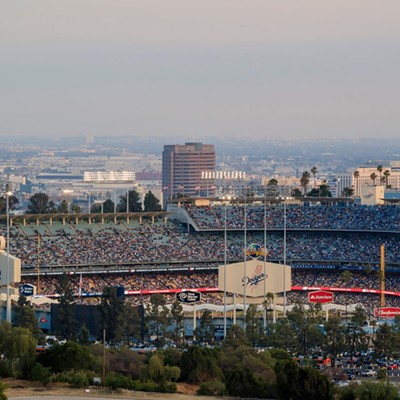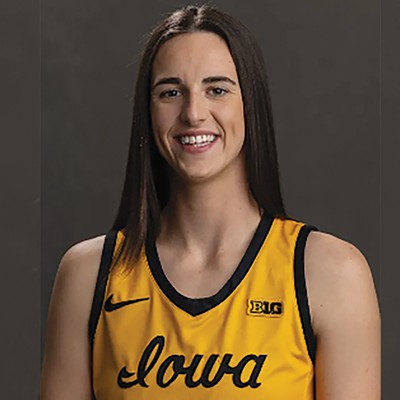The time was only decades ago. Not just in Selma, Alabama, nor Oxford, Mississippi, but right here in Tucson, Arizona. In the last of the contiguous 48 states, black people were treated no better than in the South, where hatred and bigotry were seen as a birthright.
It is a story unknown to most Tucsonans, potentially embarrassing to all. But to those who lived through those times, it is somehow a grudging badge of honor, a silent source of pride at having endured the degradation, battled the unfairness and survived to see a (somewhat) better day.
Many of those survivors who remember the time when Arizona's bigotry was more oppressive than the heat and the laws more absurd than the petty folk who clung to them for an artificial sense of superiority gather every couple years to see old friends and to bask modestly in the warmth of the victories won through silent dignity and unflinching perseverance.
The gathering is known as the Dunbar Reunion, and this year's was held Thanksgiving weekend at the Inn Suites on Granada and St. Mary's, less than a mile from the place where most of these people spent the majority of their education lives. Boarded up and broken down, the building that ended its function as John Spring Junior High School in 1978 was for decades the all-black Dunbar School.
Named for black poet (and son of a former slave) Paul Laurence Dunbar, the school was one of many throughout the country whose racist function was automatically identifiable by its name. After segregation was struck down by the courts, many Dunbar schools changed names. However, there are still several schools in the country that bear that name, including well-known high schools in Texas and Maryland.
Willie Fears, the organizer of this year's reunion, spent six years at Dunbar School and remembers it like it was yesterday. Sharp-eyed and quick-witted, Fears recounts those days lovingly and somehow without a trace of bitterness. When pressed on issues, she shrugs and sighs what is almost the mantra for Tucson Dunbar alumni: "That's just the way it was back then."
Fears was born in Ferris, Texas, and came to Arizona in 1938. Her father got a job as a cowboy and her mother as a cook at a guest ranch. They lived in a house near the intersection of Fourth Avenue and Sixth Street, just a couple blocks from Roskruge Elementary.
"That didn't matter how close we were to a school. We all went to Dunbar. There weren't a whole lot of black folks in Tucson at the time, but the ones who were here tended to live in one of three places -- out by A Mountain, down south by where Kino Hospital is now, and west of the University," recalls Fears.
A lot of the African-Americans had come west with the military or for jobs in the fields. They would find that their new home was little different than the places whence they had come.
"It was definitely segregated," says Fears. "You knew early on where you could go and where you couldn't go. Some of the stores and all of the restaurants -- you knew you weren't welcome. You couldn't go in and you knew better than to try to get a job there. Plus, you couldn't ride on an airplane, and if you wanted to ride on a train, you had to sit in the segregated car and couldn't eat in the dining car.
"And the movie theaters -- the Fox, Rialto and the Lyric -- they were segregated. We had to sit upstairs in the balcony and we had different restrictions on us than the white kids."
The most humiliating thing Fears remembers about growing up in Tucson was the public swimming pool at what is now Oury Park. During the blistering days of summer (and before widespread availability of swamp coolers), a swimming pool was an oasis of untold glory.
In Tucson, however, they had Negro Day. It was on Thursdays. The first three days of the week, the pool was used by Anglos and Hispanics. (In virtually every interview I conducted, Dunbar alumni invariably referred to Hispanics as "Mexicans," the common -- and apparently proper -- term of the day.) Blacks were allowed to swim on Thursdays, after which the pool was drained, cleaned, and made ready for the all-Anglo weekends.
(In a recent article in the Los Angeles Times, a man who had the responsibility of draining and cleaning the massive Brookside Pool near the Rose Bowl in Pasadena overnight after each "Negro Day," admitted that in the 30 years that he had the job, he never once drained the entire pool. Instead, he would drain off a foot or so, as he did every other night, check the chemicals, and then get a good night's sleep on the county's dime.)
After completing her studies at Dunbar, Fears went on to integrated Tucson High. "That was the very strange part. We were segregated for the first nine grades (high school was only 10th, 11th and 12th grades back then), and then we're sent on to an integrated high school. "
It was, in reality, a form of pragmatic racism, if you'll pardon the incongruence. The school system didn't want to and couldn't afford to build and maintain a separate black high school, so Jim Crow had a ninth-grade ceiling.
"Tucson High wasn't completely integrated, you understand," explains Fears. "We had separate black homerooms and the black girls belonged to something called the Phyllis Wheatley Club. But the sports teams and most of the classrooms were integrated. Still, you knew real well where the lines were drawn. When I was at Dunbar and Tucson High, I knew how things were and how they had always been."
WITH ALL DUE respect to Fears, things hadn't always been that way, and more the shame. During the late 1800s, blacks, Hispanics and Anglos all attended school together, and it was no big deal. It wasn't until statehood that segregation set in.
Tucson readily complied with the new state segregation law. The city was not always the liberal, forward-thinking place it is today. When Arizona first received territorial status in 1863, the capitol was located at Fort Whipple near Prescott because it was widely understood that Arizona's then-largest town, Tucson, was overrun with segregationists and Confederate sympathizers.
The first all-black school in Tucson was in a building at Sixth Avenue and Sixth Street. It was called the Tucson Colored School. The school was later moved to the site on Second Street and renamed the Dunbar School. And there it remained until the century was half-over.
In 1940, a principal was brought in from Kansas and given the job of running the school. That man was Morgan Maxwell, for whom is named the far-westside middle school that just this year was featured in a series of national commercials for a computer company. Fortunately, he lived long enough to attend the opening in 1973 of the school named for him, and then lived another 14 years after that.
Maxwell ran a tight ship and let it be known that he and the faculty all had high expectations on all of the students.
"I think in many ways the education we received at Dunbar was superior to what we got at Tucson High," says Fears. "Mr. Maxwell brought a lot of very good teachers from Kansas and they were all business. We had to work hard in those classrooms. I think more was expected from us at Dunbar than at Tucson."
Maxwell's Kansas pipeline was very productive. At one time, eight of the 17 teachers at Dunbar were from Kansas. One who wasn't was Elgie Batteau, who attended high school in Texas and is generally considered to be the first-ever female African-American graduate of the University of Arizona.
In an interview conducted in 1988, Batteau, then 83, recalled her days at Dunbar. "Among all the problems blacks had to endure, the black woman had to endure more," she stated. "A woman teacher could not be married; nor could she live alone. For young black teachers it was pretty tough."
Still, the Dunbar School and its students thrived, through the Depression and into the Second World War. The entire school would march in the annual Rodeo Parade and would be treated to visits from virtually every black celebrity who came through town. Willie Fears remembers visits from boxer Joe Louis, opera star Marian Anderson, Oscar winner Hattie McDaniel and even the illustrious poet Langston Hughes. They would stop by Dunbar and then later appear at a free Sunday Evening Forum at the UA.
One of the students of that time, Morgan Maxwell Jr., the son of the principal, remembers the odd contrasts.
"We had a nice house; Dad made the same amount of money as the principals of the other schools in the district. But there were a lot of things we couldn't do. Couldn't eat at restaurants, and I do like to eat.
"But there was a strip of black-owned businesses down on Meyer Street. There were restaurants we could go to there, but we couldn't go to Chinese or Mexican restaurants. Seems kinda silly, but that's just the way things were back then. Those were the rules of the game."
When Maxwell got to Tucson High, one of his football teammates was Frank Borman, who would go on to become an Apollo astronaut and head of Eastern Airlines. Borman and Maxwell were roommates on the road and worked summer jobs together at Yosemite National Park. In his autobiography, Borman tells of the time the Badger football team went down to the border town of Douglas to play the DHS Bulldogs.
Arriving in town that day, the team went to the ornate and historic Gadsden Hotel on G Avenue for a pre-game team meal. As the food was being prepared and served, someone from the hotel noticed that the light-skinned Maxwell was actually, as they said back then, "of African descent," and told the coach, Rollin T. Gridley, that Maxwell, the only black on the team, was unwelcome in the restaurant.
Without making a fuss, Gridley told the entire team to get up from where they were seated and to walk out of the restaurant and hotel. They went and grabbed some meat and bread at a store and had a little picnic in a park before waxing the Douglas team on the gridiron.
It was an episode that Borman says shaped his entire life in terms of race relations and the dignity and strength of conviction with which his coach handled the matter.
Gridley, who also has a local school named for him, is still alive and will turn 96 this month.
MAXWELL SITS AT a table with a view of the pool at the Inn Suites and reflects on those conflicting days.
"I remember Tucson High really well. The sports teams were integrated, but the lines of distinction were very clear. For example, white kids had separate clubs; all we could belong to was the Paul Robeson Choir." (This was apparently before the multi-talented Robeson fell out of favor with J. Edgar Hoover and the entire U.S. Government over his politics.)
"Even the housing patterns were controlled. Most of the black people I knew lived in an area west of the University. Oh, some lived out by A Mountain. The house I lived in on 10th Avenue is now owned by my nephew, Melvin Dixon (a prominent local dentist). It was up close to Speedway, but back then, no blacks lived north of Speedway."
(Willie Fears, who worked in local government for years, says that there used to be deed restrictions that prohibited blacks from living north of Speedway. While it may or may not have been the actual law -- there is some contention over that point -- it was definitely controlled through real-estate transactions and arcane deed restrictions.)
"I had white friends and white teammates," Maxwell recalls, "but the lines were everywhere. Speaking of lines, when we graduated in 1945, just a couple weeks after V-E Day in World War II, the black kids had to march at the end of the line in the graduation ceremony, behind the whites and the Mexicans."
After graduating from THS, Maxwell attended the UA. He graduated in 1949 with a degree in business and finance and later earned an MBA from the University of Southern California. He has owned his own real-estate appraisal business in Tucson since 1960.
Speaking to him, I noticed that the 70-something Maxwell has no gray hair. I have to ask. He just shrugs and smiles.
From the next table, Alfonso Harris weighs in on the matter. "Maybe he and Ronald Reagan have the same hairdresser," he offers, drawing a big laugh from those within earshot.
Harris is a rarity: someone over the age of 15 who was actually born in Tucson. His father worked for the Southern Pacific railroad and they lived away from Tucson for a while before Alfonso returned to attend seventh through ninth grades at Dunbar.
He went on to Tucson High, where he excelled in track, twice winning the state championship in the 440 yard run. However, one time on the way to a big track meet, he stopped in at a little diner across the street from the school and tried to get something to eat. The guy behind the counter knew him, but still said no to his request for food. He even gave Harris a stern lecture on propriety.
When asked if he had received any scholarship offers, Alfonso Harris just smiles.
"I wasn't ready for college. Tucson High did nothing to prepare me for college. I didn't take any of the necessary courses. Black kids were put in vocational classes, wood shop and things like that. All the girls took home economics and the boys took shop classes. I guess they thought they were doing us a favor."
Upon graduation, he received a greetings letter from his Uncle Sam. With hostilities raging in Korea, Harris had an epiphany of sorts.
"I decided that if I was going to go off and fight and maybe die for America, I ought to at least be treated like one of its citizens."
He decided to make a stand that day. He walked down to the nearest movie theater and bought a ticket. Once inside the theater, he headed for the main auditorium, not the balcony.
"I was ready for this big showdown, but nobody said a word. So I just sat down and watched the movie."
Harris then spent 20 years in the Air Force and is currently living in, of all places, Utah.
THE DUNBAR STORY came to an end, as they say, not with a bang but with a whimper. In 1949, five years before the famous Brown v. The Board of Education Supreme Court decision, Tucson Superintendent of Schools Robert T. Morrow, for whom TUSD's administrative offices are named, began advocating to integrate the schools. He made the decision, stuck to it, and faced very little open opposition.
Morrow showed up at Dunbar one day and told all the kids to attend whatever school was closest to them when classes resumed after the summer break. And that was that.
In the fall of 1951, Dunbar was renamed John Spring and reopened as an integrated school.
Ira Andrews, who attended Dunbar at the end, felt proud of Tucson. Andrews would go on to star in basketball at Tucson High in the late 1950s, along with teammate and local businessman Tom Hassey.
Andrews, who has owned several small business and is now semi-retired, sells Hondas part-time at Dobbs Honda. On his desk is a picture of a young Ira Andrews decked out in a Tucson High basketball uniform.
"I remember when we played teams from Phoenix. They still had Carver High. (The official name was George Washington Carver Vocational Colored High School.) The kids from Phoenix were impressed that we had integrated before they did, and before the federal government said we had to."
And so they gather, more than 200 this past weekend, to remember what was and count their blessings for what is. They used to have reunions every five years, but now it's every two years. ("The names on the left side of the ledger are getting fewer and the ones on the right side are piling up," explains Alfonso Harris, "so we need to do this every couple years.")
They don't want sympathy nor reparations. They just want it to be remembered lest, God forbid, it happen again.
"People just have to know that this happened in Tucson, Arizona," says Willie Fears.
"People just have to know."











